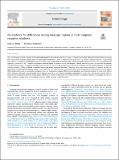| dc.contributor.author | Blank, Idan Asher | |
| dc.contributor.author | Fedorenko, Evelina G | |
| dc.date.accessioned | 2022-03-11T23:11:13Z | |
| dc.date.available | 2021-10-27T20:29:54Z | |
| dc.date.available | 2022-03-11T23:11:13Z | |
| dc.date.issued | 2020 | |
| dc.identifier.issn | 1095-9572 | |
| dc.identifier.uri | https://hdl.handle.net/1721.1/135909.2 | |
| dc.description.abstract | © 2020 The Authors The “core language network” consists of left frontal and temporal regions that are selectively engaged in linguistic processing. Whereas functional differences among these regions have long been debated, many accounts propose distinctions in terms of representational grain-size—e.g., words vs. phrases/sentences—or processing time-scale, i.e., operating on local linguistic features vs. larger spans of input. Indeed, the topography of language regions appears to overlap with a cortical hierarchy reported by Lerner et al. (2011) wherein mid-posterior temporal regions are sensitive to low-level features of speech, surrounding areas—to word-level information, and inferior frontal areas—to sentence-level information and beyond. However, the correspondence between the language network and this hierarchy of “temporal receptive windows” (TRWs) is difficult to establish because the precise anatomical locations of language regions vary across individuals. To directly test this correspondence, we first identified language regions in each participant with a well-validated task-based localizer, which confers high functional resolution to the study of TRWs (traditionally based on stereotactic coordinates); then, we characterized regional TRWs with the naturalistic story listening paradigm of Lerner et al. (2011), which augments task-based characterizations of the language network by more closely resembling comprehension “in the wild”. We find no region-by-TRW interactions across temporal and inferior frontal regions, which are all sensitive to both word-level and sentence-level information. Therefore, the language network as a whole constitutes a unique stage of information integration within a broader cortical hierarchy. | en_US |
| dc.description.sponsorship | NIH award (R00-HD057522) | en_US |
| dc.description.sponsorship | NIH award (R01-DC016607) | en_US |
| dc.description.sponsorship | NIH award (R01-DC016950) | en_US |
| dc.language.iso | en | |
| dc.publisher | Elsevier BV | en_US |
| dc.relation.isversionof | https:dx.doi.org/10.1016/J.NEUROIMAGE.2020.116925 | en_US |
| dc.rights | Creative Commons Attribution-NonCommercial-NoDerivs License | en_US |
| dc.rights.uri | http://creativecommons.org/licenses/by-nc-nd/4.0/ | en_US |
| dc.source | Elsevier | en_US |
| dc.title | No evidence for differences among language regions in their temporal receptive windows | en_US |
| dc.type | Article | en_US |
| dc.contributor.department | Massachusetts Institute of Technology. Department of Brain and Cognitive Sciences | en_US |
| dc.contributor.department | McGovern Institute for Brain Research at MIT | en_US |
| dc.relation.journal | NeuroImage | en_US |
| dc.eprint.version | Final published version | en_US |
| dc.type.uri | http://purl.org/eprint/type/JournalArticle | en_US |
| eprint.status | http://purl.org/eprint/status/PeerReviewed | en_US |
| dc.date.updated | 2021-03-22T15:28:24Z | |
| dspace.orderedauthors | Blank, IA; Fedorenko, E | en_US |
| dspace.date.submission | 2021-03-22T15:28:26Z | |
| mit.journal.volume | 219 | en_US |
| mit.license | PUBLISHER_CC | |
| mit.metadata.status | Publication Information Needed | en_US |
